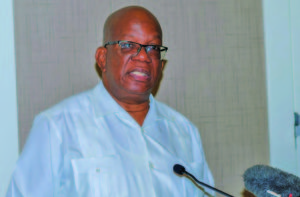
Winston Jordan
Despite Guyana’s economy growing by 4.5 per cent in the first half of 2018, the traditional sectors, such as sugar and rice, have seen decline in their performances, with contractions of 30.6 and 3.8 per cent respectively.
This was revealed in the Finance Ministry’s Mid-Year Report 2018, which was laid in Parliament on Wednesday and which focuses on the state of the economy and performances of various sectors.
Finance Minister Winston Jordan, in addressing the National Assembly about the country’s economic performance, admitted that the gold sector also suffered a decline of 9.1 per cent.
This is equivalent to a decrease of 288,114 ounces in gold declaration. The report also revealed that this represented a 19.4 percent shortfall (below the original projection set by Government).
The minister in his report also noted that there are a number of downside economic and fiscal risks to the economy, both domestic and external, which can frustrate the achievement of the various revised targets.
In relation to sugar production, the report stated that this continued to be impacted negatively by a sub-optimal mix of factors, which also include deficient cash flow alignment and the undue absence of a board to oversee the management of the remaining sugar estates.
“The SPU (Special Purpose Unit) will need to accelerate efforts to divest/diversify the closed estates in order to provide a much-needed injection of cash to facilitate retooling and the continued operations of the restructured Guyana Sugar Corporation (GuySuCo) under the soon-to-be-named board,” it stated.
Importantly also, the report added that if this does not materialise quickly, there is a real danger of GuySuCo renewing its reliance on the treasury beyond the sum budgeted in 2018. Government recently named a new Chief Executive Officer for the company, and has promised to name a new board soon.
Higher-than-expected levels of rainfall and the impact of climate change were also cited as economic and fiscal risks. The report noted that this continues to threaten economic activity across several sectors within the economy, particularly sugar, rice, forestry, mining and construction.
Another issue listed in the report is the pace of implementation of the Public-Sector Investment Programme (PSIP). It improved from 23.6 percent on average to 31.8 percent at the first half of the year, with several constraining factors continuing to stymie further progress.
Inadequate leadership, it said, is further complicated by a limited pool of evaluators and qualified contractors; the absence of procurement by a limited pool of qualified contractors; the absence of procurement planning; and the inability to attract qualified engineering and procurement specialists.
“Cabinet is in the process of addressing the weak management across budget agencies undertaken the PIMA, an action plan has been drafted and implementation of project appraisal systems is anticipated to improve the pace of implementation in future years,” it also noted.
Growth
However, despite these issues, the report indicated that growth in the economy was more broad-based than in 2017, with robust performances in the agriculture, fishing and forestry sectors of 3.4 percent. Other crops, fishing, livestock and forestry industries all experienced growth over the same period, with the latter two growing by a commendable 29.1 percent and 18.1 percent respectively.
Growth of 8.2 percent was also recorded in the services sector, and 13.4 per cent in the construction sector. This significant increase in the construction sector is attributed to higher building imports by 24.7 per cent.
Meanwhile, production in the bauxite industry reached its highest level since 2013, surpassing 2017 by 21.1 per cent. This has led to a revision of the forecast growth of the industry upward from 23.3 per cent to 29.9 per cent. There was also growth in other mining of 31.2 percent, driven by the production of diamonds and other stones, which increased by 13.3 per cent and 45.5 per cent respectively.
In addition to that, the Government has also revised its growth rate for 2018 to 3.7 per cent, which is close to the initial rate of 3.8 percent. Government has subsequently revised the economic growth rate for 2018 to 3.4 percent. This figure was touted a few months ago after several revisions were made.
Guyana’s last best growth rate was 5.2 per cent, recorded in 2013. World Bank records show Guyana’s growth rates as follows: in 2014, it was 3.8 per cent; in 2015, it was 3.2 per cent; and in 2016, it was 3.3 per cent. For 2017, initial projections of 3.8 per cent were revised to 3.1 per cent. This figure then went to 2.9 per cent before the final figure of 2.1 per cent was determined.



